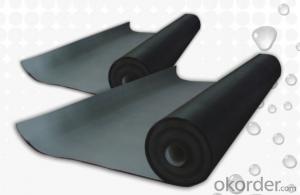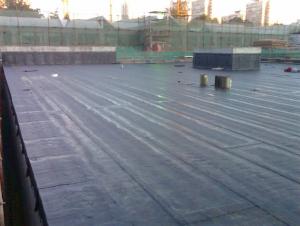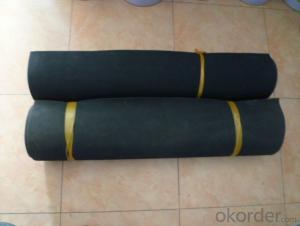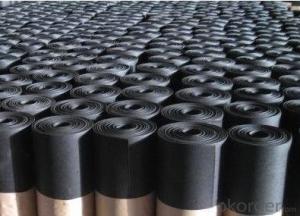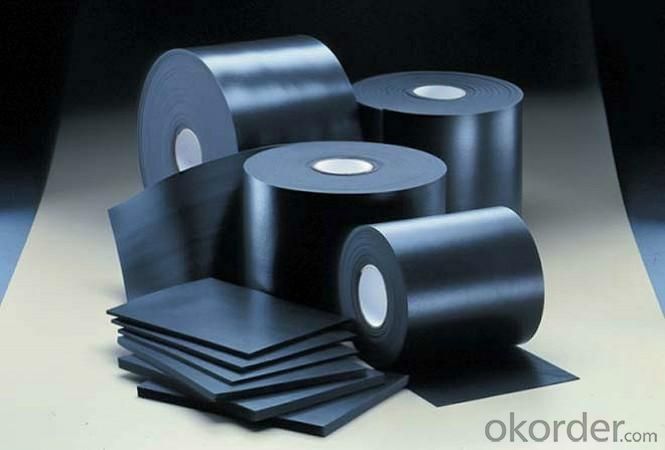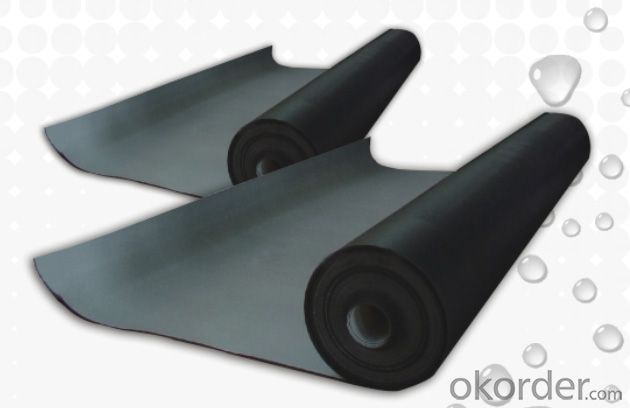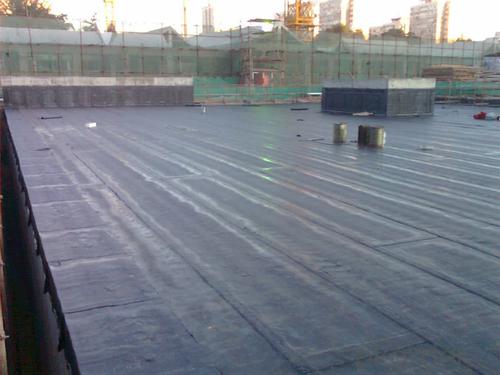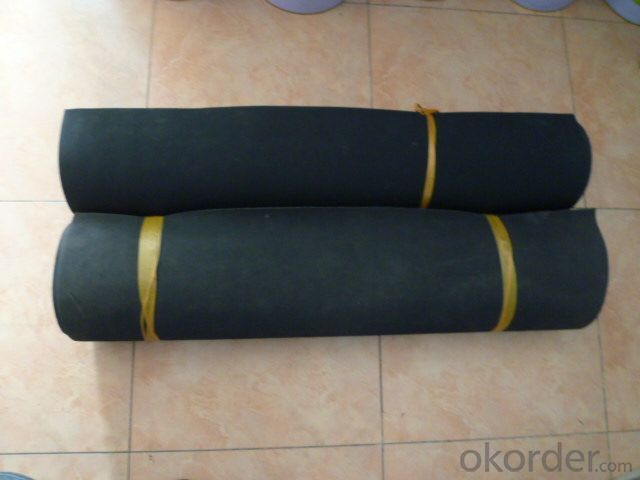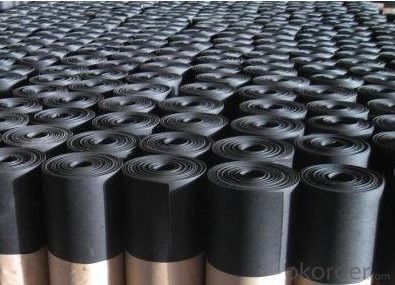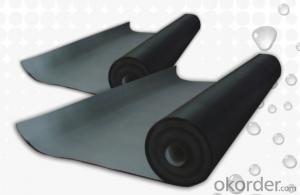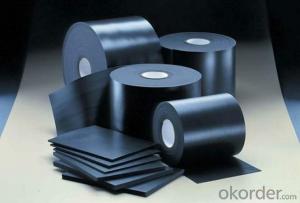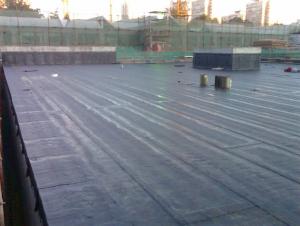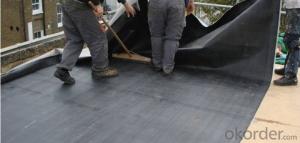EPDM Coiled Rubber Waterproof Membrane for Roof Waterproof System
- Loading Port:
- Shanghai
- Payment Terms:
- TT or LC
- Min Order Qty:
- 10000 m²
- Supply Capability:
- 1200000 m²/month
OKorder Service Pledge
OKorder Financial Service
You Might Also Like
EPDM Coiled Rubber Waterproof Membrane for Roof Waterproof System
Description Of EPDM Coiled Rubber Waterproof Membrane for Roof Waterproof System:
1. EPDM waterproof membrane is made from ternary ethylene-propylene rubber, which is for waterproofing of exposed and non-exposed applications.
2. EPDM waterproof membrane production adopts the world-advanced equipment of cold feeding extrusion and continuous vulcanization technology.
3. EPDM waterproof membrane is of high elasticity among high polymer waterproof materials and becomes a world-popular waterproofing material.
Main Features of EPDM Coiled Rubber Waterproof Membrane for Roof Waterproof System:
1. Excellent physical and mechanical performance
2. High tearing resistance
3. Good deformation adaptability
4. High puncture resistance
5. High aging resistance
6. UV resistance
Specifications of EPDM Coiled Rubber Waterproof Membrane for Roof Waterproof System:
| Material | EPDM Rubber |
| Size | 1.2m (width)*20m (length) or customized, weldable type 2.05m or 4m width |
| Thick | 1.2mm, 1.5mm, 2.0mm |
| Type | Vulcanized & Weldable |
| Pattern | Non-reinforced (homogeneous) |
| Certificate | ISO9001/14001 |
Applications of EPDM Coiled Rubber Waterproof Membrane for Roof Waterproof System:
1.Roofs, Basement, Toilets
2. Industrial and civil building waterproofing
3. Geosynthetic liner for swimming pool, channels, irrigation system
4. Especially suitable for projects with high requirements in durability, anti-corrosion and deformation.

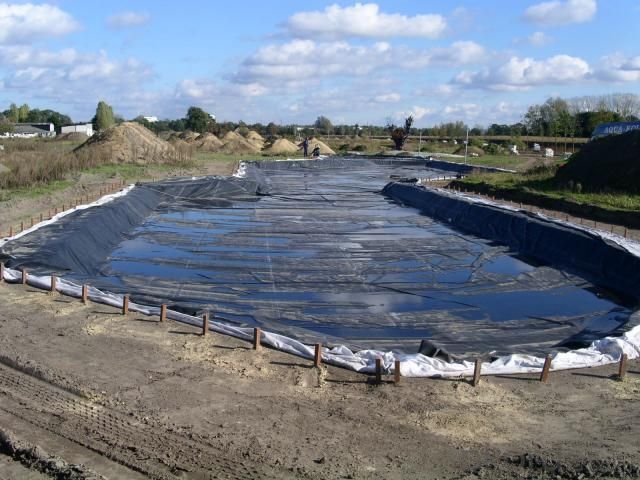

IMages of EPDM Coiled Rubber Waterproof Membrane for Roof Waterproof System:




FAQ of EPDM Coiled Rubber Waterproof Membrane for Roof Waterproof System:
1. What are we supplying?
We are specialized in producing Colorful Asphalt Roof Shingle, SBS/APP modified bitumen waterproof membrane, Self adhesive bitumen waterproof membrane, PVC waterproofing membrane, EPDM rubber roofing membrane, Single Component Polyurethane Waterproof Coating, and Spray Polyurea Waterproof Coating
.
2. How Many years experience do we have?
We have been exported to more than 20 countries in the past 15 years.
3. How long do we usually reply your request?
We always reply our customer within 24 hours.
- Q: Can a waterproofing membrane be used on precast brick block surfaces?
- Precast brick block surfaces can indeed benefit from the application of a waterproofing membrane. Such a membrane serves as a protective shield, safeguarding the bricks against water infiltration, which could otherwise lead to undesirable consequences like cracks, efflorescence, or the growth of mold. It is crucial to select a waterproofing membrane explicitly designed for masonry surfaces, as these membranes are specially formulated to adhere perfectly to the distinct properties of brick and block materials. Moreover, to guarantee the membrane's effectiveness, it is essential to adhere to proper surface preparation and application techniques.
- Q: Are waterproofing membranes suitable for residential basements?
- Yes, waterproofing membranes are suitable for residential basements. These membranes are designed to prevent water infiltration and protect the basement against moisture damage. They create a barrier that keeps water out, helping to keep the basement dry and free from water-related issues like mold and water damage.
- Q: Are there any specific considerations for installing a waterproofing membrane on wood surfaces?
- Yes, there are several specific considerations for installing a waterproofing membrane on wood surfaces. Firstly, it is important to ensure that the wood surface is clean, dry, and free from any debris or loose material. This will help in achieving a proper adhesion of the waterproofing membrane. Additionally, it is crucial to choose a membrane specifically designed for wood surfaces, as they may require additional flexibility and resistance to expansion and contraction. It is also recommended to apply a primer or sealer to the wood surface before installing the membrane to improve its adhesion and longevity. Lastly, regular inspection and maintenance of the waterproofing membrane is essential to identify any potential issues and ensure its effectiveness over time.
- Q: Does a waterproofing membrane require any curing time before it can be exposed to water?
- Yes, a waterproofing membrane generally requires a curing time before it can be exposed to water. The specific curing time may vary depending on the product and manufacturer's instructions. It is important to allow the membrane sufficient time to cure and bond properly to ensure its effectiveness in preventing water penetration.
- Q: Are waterproofing membranes resistant to mineral oils?
- Yes, waterproofing membranes are generally resistant to mineral oils.
- Q: Can a waterproofing membrane be used on below-grade foundations?
- Yes, a waterproofing membrane can be used on below-grade foundations. Waterproofing membranes are commonly used to prevent water infiltration and protect the foundation from moisture damage in below-grade applications.
- Q: Does a waterproofing membrane require any specific surface preparation for tile installations?
- Specific surface preparation is required for tile installations when using a waterproofing membrane. The longevity of the tile installation and the success of the waterproofing membrane depend on proper surface preparation. Before applying a waterproofing membrane, it is vital to confirm that the surface is clean, dry, and free from contaminants such as dust, debris, oil, grease, or any loose or crumbling materials. Thoroughly cleaning the surface is necessary and removing any existing tile, adhesive, or grout may be required. In addition to cleanliness, achieving a smooth and even surface is important. Any uneven areas or imperfections should be leveled and patched with an appropriate patching compound. This step prevents water from pooling or seeping beneath the waterproofing membrane, which could cause issues like leaks, mold growth, or damage to the tile installation. Moreover, ensuring the surface is structurally solid and stable is essential. Addressing and repairing any cracks, weak areas, or signs of instability before installing the waterproofing membrane is necessary. This establishes a sturdy foundation for the tile installation and prevents future problems. To summarize, proper surface preparation is critical for the success of both the waterproofing membrane and the tile installation. It guarantees a clean, smooth, and stable surface, which is essential for the membrane to adhere effectively and provide reliable waterproofing. Following the manufacturer's guidelines and seeking professional advice if necessary will help ensure correct surface preparation for a durable and dependable tile installation.
- Q: Can a waterproofing membrane be used on precast aluminum surfaces?
- Indeed, precast aluminum surfaces can be effectively protected by utilizing a waterproofing membrane. These membranes are specifically engineered to safeguard various surfaces, encompassing concrete, metal, and other materials, against water infiltration. By acting as a formidable barrier, the membrane effectively thwarts the ingress of water into the precast aluminum surface. This proves to be especially advantageous in locales with elevated moisture exposure, such as surrounding swimming pools or outdoor environments. It is crucial to select a waterproofing membrane that is aluminum-compatible in order to guarantee optimal adhesion and long-lasting efficacy.
- Q: Can a waterproofing membrane be used on tile surfaces?
- Yes, a waterproofing membrane can be used on tile surfaces. A waterproofing membrane is a thin layer of material that is designed to prevent water or moisture from penetrating through to the underlying surface. It is commonly used in areas where water exposure is high, such as bathrooms, showers, or outdoor areas. When applied properly, a waterproofing membrane can create a barrier that protects the tile surface from water damage, preventing issues such as mold, mildew, or tile deterioration. It is important to ensure that the waterproofing membrane is compatible with the type of tile being used and that it is installed correctly to ensure maximum effectiveness.
- Q: Can a waterproofing membrane be used on terraces or patios?
- Yes, a waterproofing membrane can be used on terraces or patios. In fact, it is highly recommended to use a waterproofing membrane in these areas to prevent water damage and leakage. Terraces and patios are exposed to various weather conditions, including rain and snow, which can lead to moisture seeping into the underlying structure. A waterproofing membrane acts as a barrier, preventing water from penetrating the surface and protecting the integrity of the terrace or patio. It helps to extend the lifespan of the structure and prevents costly repairs in the long run. Additionally, using a waterproofing membrane also helps to create a more comfortable and usable space, as it eliminates the risk of water accumulation and potential slip hazards. Overall, investing in a high-quality waterproofing membrane is a wise decision for anyone looking to protect their terrace or patio from water damage.
Send your message to us
EPDM Coiled Rubber Waterproof Membrane for Roof Waterproof System
- Loading Port:
- Shanghai
- Payment Terms:
- TT or LC
- Min Order Qty:
- 10000 m²
- Supply Capability:
- 1200000 m²/month
OKorder Service Pledge
OKorder Financial Service
Similar products
Hot products
Hot Searches
Related keywords


